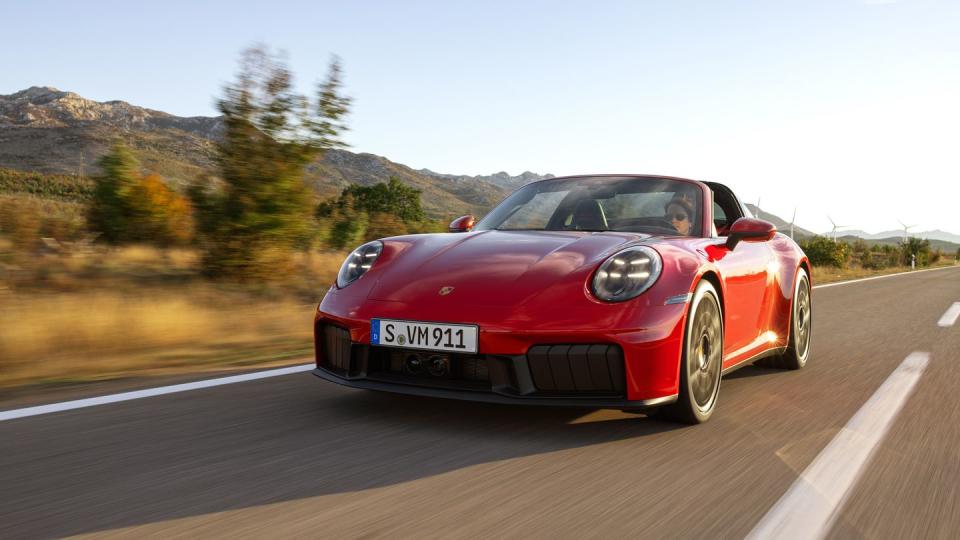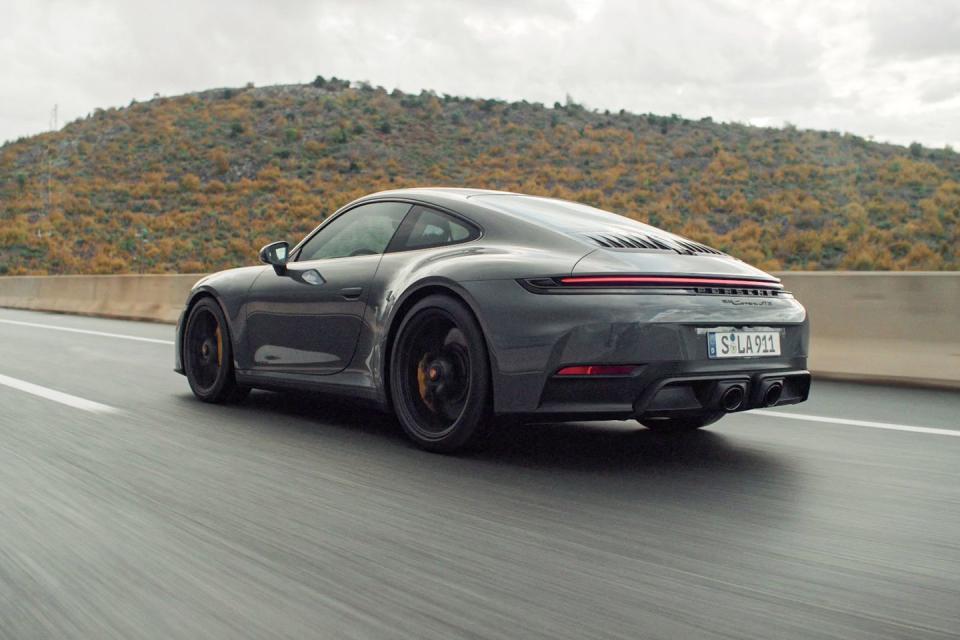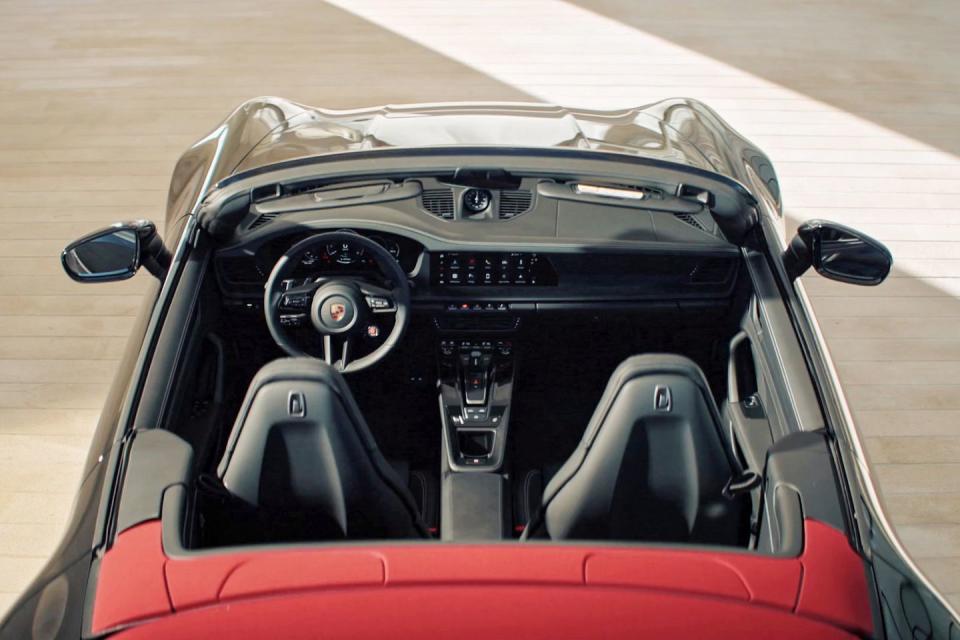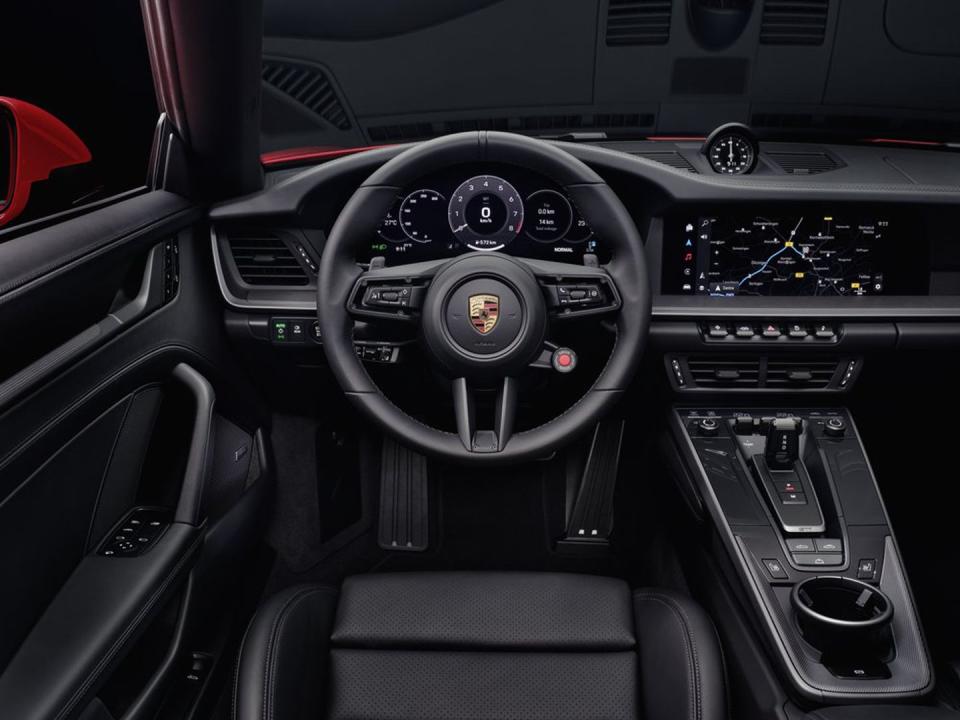2025 Porsche 911 GTS Hybrid Is Nothing like a Prius

With the arrival of the 2025 911 Carrera GTS, the Porsche 911 adds a hybrid model.
This new 992.2 gets a 3.6-liter T-Hybrid powertrain featuring an electrically enhanced turbocharger and an electric motor/generator.
The 2025 Porsche 911 Carrera's base model now costs $122,095, while the GTS is priced at $166,895.
Ever since the Honda Insight and the Toyota Prius appeared almost 25 years ago, we've become accustomed to hybrids that sacrificed performance so that they could sip fuel as reluctantly as if it were hemlock. Sure, we know that Formula 1 cars have been using hybrid powertrains for years, and we've seen the hybrid hypercars produced in handfuls by Ferrari, McLaren, and Porsche, purchased by 0.1 percenters, and destined to slowly deteriorate in static collections as they accumulate value like Picassos.
But where are the performance hybrids for the rest of us? Even Chevy's Corvette E-Ray, quick as it is, simply adds an electric motor to power its front wheels. Porsche aims to change that up and is now jumping into the game with the 2025 911 Carrera GTS—not only a dedicated performance hybrid but the vanguard of the 992.2, the current 911 generation receiving its mid-cycle upgrade.

Instead of the twin-turbocharged 3.0-liter 9A2B6 used on the 992.1, the new GTS gets the 9A3B6 engine. It displaces 3.6 liters, uses an electrically enhanced turbocharger, and is supplemented by a powerful electric motor/generator tucked into the housing of the eight-speed PDK dual-clutch transmission. Porsche calls this the T-Hybrid, which stands for Turbo Hybrid, to distinguish it from the company's PHEVs, dubbed E-Hybrids.
Though increasing in size from 3.0 to 3.6 liters and with maximum boost rising from 18.6 to 26.1 psi, the new engine's power only increases by five ponies—from 473 to 478. And peak torque rises not at all from 420 pound-feet. The culprit is Lambda 1—engine designers' shorthand for a perfectly balanced ratio of fuel and air—used at all engine operating points. With no rich mixture available during high boost, combustion temperatures rise to a point where ignition timing must be dramatically retarded to control detonation. The upside is less smog emission at full power.
The 9A3B6 also gets a massive redesign, with the goal of making it lower from the top of its intake manifold to the bottom of its plastic oil pan, and generally less bulky. This is to make room for the power control electronics for the various hybrid elements that sit above the engine. This comes with a complete repackaging of the flat-six with the single, bulky electrically boosted turbo on the right and the large muffler on the left, with the catalytic converter and particulate filter in between.
Another change is the elimination of the accessory drive. The transmission-mounted motor serves as both the starter and generator. The air conditioning compressor is now driven by a 400-volt motor via the high-voltage hybrid circuit, and the water pump has been moved inside the engine and driven by an extension of the oil pumps. The various changes have shaved 40 pounds from the weight of the engine.
The single turbocharger is a Borg-Warner unit with a 27-hp electric motor sandwiched between the compressor and exhaust sides of the turbo. This motor greatly reduces turbo lag at low revs. For example, at 2000 rpm with a closed throttle, the old GTS required over three seconds to achieve full boost when the throttle was floored, while the new GTS does it in slightly less than one second—and that's while achieving considerably higher pressure.
This new electric turbo has no waste gate. Instead, at high rpm, the motor turns into a generator and harvests up to 15 horsepower, in the process of providing enough drag to keep the turbo from overspeeding. That electricity feeds into the electric motor and supplements total power from about 5700 rpm at full throttle.

The final power-producing element is the electric motor/generator fitted to the eight-speed PDK, which replaced the seven-speed transmission at the 992's launch for exactly this eventuality. The motor can provide a maximum of 54 horsepower and about 110 pound-feet of torque. Power rises from 478 to 533 horses, and torque swells from 420 pound-feet to 449. Perhaps more important, it delivers its 110 pound-feet to supplement engine output at low revs even before the electric turbo can spool up.
A 1.5-kWh (estimated, net) lithium-ion battery operates at a nominal 400 volts. It weighs about 60 pounds and is about the same size as a 911's lead-acid battery. A small, separate lithium-ion battery provides 12 volts for those systems that require it when the engine isn't running.
Despite Porsche's weight-saving efforts on the engine, all of this hardware does come at a price. Curb weight for the GTS coupe rises from 3433 to 3536 pounds, compared with a 992.1 PDK. Compared to the older manual, which will no longer be available, the weight increase is 187 pounds.
Porsche also revealed the base 992.2 Carrera with a much more modest powertrain evolution. It retains the 9A2B6 engine, but also adopts the Lambda 1 philosophy to reduce full power exhaust emissions. In this case, peak boost rises from 12.0 to 17.4 psi—higher than the 992.1 Carrera S. To provide this much airflow, the engine gets the larger turbochargers used on the previous S and GTS, as well as the bigger intercooler from the 911 Turbo. Peak power rises modestly, from 379 to 388 horsepower, still at 6500 rpm, and peak torque is unchanged at 331 pound-feet.
Changes Inside and Out
Both cars also receive a number of interior and exterior changes. All cars get new headlights that incorporate all of the front lighting functions. This allows for larger air intakes for the front-mounted radiators. The GTS (but not the base model) gets active grille shutters to control airflow as needed, and these elements are vertical and very prominent. Furthermore, they are supplemented by an active front diffuser, which further regulates the airflow through the radiators.
In the rear, the full-width light bar, taillights, and Porsche script have been more fully integrated, the license plate cutout is a bit higher, and the engine grille has fewer strakes. On the GTS, with the standard sport exhaust, the twin tailpipes are closer together.
Several new wheel designs are offered in staggered 19- and 20-inch diameters, as well as in the 20s and 21s used on the GTS. Tire sizes are the same except for the rear of the GTS, where the width increases from 305 mm to 315 mm to cope with that model's increased power.
Inside, the big news is a fully digital 12.6-inch instrument cluster. Several different display options are offered including the classic center-tach, five-gauge layout. And even that is customizable. One option is to rotate the tachometer so that 7000 rpm aligns straight up.

A Brief Ride on the Handling Track
We didn't have an opportunity to drive the new cars, but we did enjoy a couple of hot laps in the GTS on the handling track at Porsche's Weissach development center. At the wheel was Jörg Bergmeister, one of Porsche's resident hotshoes, and his mastery of this treacherous track, which has virtually no runoff, was impressive.
The car rocketed out of corners with instantaneous throttle response—no surprise at high rpm—and displayed very powerful brakes and tremendous grip. We hit an indicated 155 mph on the longest straight of roughly 2200 feet.
According to Porsche, in Bergmeister's hands the new GTS (equipped with the optional aero kit with a fixed rear wing but standard tires) got around the Nordschleife in 7 minutes and 16.9 seconds, 8.7 seconds quicker than its predecessor. Porsche also claims that zero-to-60-mph acceleration drops from 3.2 to 2.9 seconds, and top speed rises by 1 mph to 194. Given that we measured 2.8 seconds to 60 for the 992.1 GTS, we'd expect the new model to be around two and a half seconds. And a quarter-mile of maybe 10.6 seconds in the low 130s would also seem in the cards.
But the most impressive change might be in general street driving. Porsche says that when you floor the throttle from a dead stop, the new GTS covers 70.5 feet in the first two and a half seconds, compared to 47.6 feet for the old GTS. That astonishing improvement reflects the improved throttle response and should translate into great street performance.
The improvements in the base Carrera are much more modest, with the time to 60 improving by a tenth to 3.7 seconds with the Sport Chrono package and 3.9 without. And top speed rises to 183 from 182 mph. Fuel-economy numbers are not yet available for either car.
Prices
Pricing, however, has been released. The base Carrera now costs $122,095, up about six grand from before. The GTS rises over 14 grand to $166,895, no surprise given its additional technology. The convertible version adds an additional $13,300, while all-wheel drive (on the GTS only, for now) adds $7800. And then there is the dizzying array of options to take you tens of thousands higher.
We've grown accustomed to, if not comfortable with, such nosebleed pricing. But the reality is that these 911s provide a unique driving experience, which Porsche manages to maintain, while adding more performance with every incremental generation. We look forward to driving these models—and figuring out how to afford one.
You Might Also Like

 Yahoo Autos
Yahoo Autos 